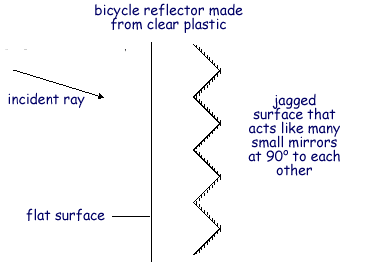Questions on Light
Q11. Two mirrors at 90° to each other always reflect a ray of light back parallel to the incident ray.
(a)
(i) In the diagram below, a ray of light strikes mirror 1 at an angle of 45°. Complete the diagram to show how the mirrors reflect the ray. Use a ruler and a protractor.


1 mark
(ii) In the next diagram, a ray of light strikes mirror 1 at a different angle. Complete the diagram to show how the mirrors reflect the ray. Use a ruler and a protractor.

1 mark
(b) Bicycles must have a reflector fixed to the rear mudguard or to the seat. The diagram shows part of a bicycle reflector and an incident ray of light. The light passes through the flat surface and is reflected from the small 'mirrors'.

(i) In which direction is the ray of light reflected?
- Back - parallel to the direction it was travelling at originally.
- The reflected ray will be parallel to the incident ray.
- The reflected way is at 180o to the incident ray.

1 mark
(ii) At night, car drivers can easily see bicycle reflectors in the beam from their headlights. Explain why.
The reflector reflects the light from the car headlights back towards the car. 
1 mark
(iii) Why is a plane mirror not suitable as a bicycle reflector?
Light would probably not be reflected back towards car or driver 
Accept 'light is reflected in a different direction or away'
do not accept 'it would dazzle the driver'
1 mark
Maximum 5 marks


